Setup (optional)
If you don’t want to run it on your computer, please skip to this section
First, we need to install V8 to be able to run it without whole package (node or web browser). I’ve created gist describing the process for Linux users.
https://gist.github.com/burnpiro/d85d836200df93af892877c2cf37f12c
If you’re a Mac user, it should apply to you as well. If you have any problems with installation process, please refer to Official Docs
After installing you should be able to run code like
// index.js
console.log('it works');by calling
d8 index.jsWhat are we trying to optimize?
Our test function looks like that:
function test(obj: any): string {
let result = '';
for (let i = 0; i < N; i += 1) {
result += obj.a + obj.b;
}
return result;
}Let’s assume this function is called thousands of times during our script execution so it’s important to run quickly. Before I explain how that is optimized in V8 we need to know what are Shapes and how Inline Cache (IC) works.
Shapes (Maps in V8)
Academic name of the Shape is “Hidden Class” which might be confusing especially in JS so everyone calls it differently, but name introduced by FF team is probably best.
Shape contain a lot of staff, but when people use that name they mostly referring to it as a table of descriptors for object properties. Shape stores other information as well, like size of the object and pointers to constructors and prototypes. I’m going to show you that in the example soon.
Let’s start with a simple object:
const obj = {
x: 1,
y: 1,
};It’s representation in V8 looks like
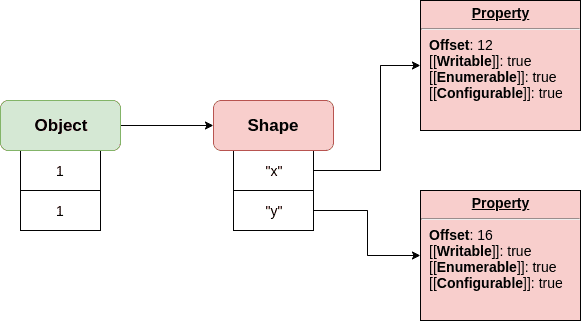
If you look on it, there is an obvious distinction between object values and their description. Every property on that object is stored in memory according to offset defined in shape. In our case property x is stored with offset: 12 which tells v8 to look for obj.x value by offsetting pointer by 12.

Ok, so now you know what a Shape is but why is it so useful?
Shape’s usefulness
When you create an object, you don’t really want to store all information about it again if you have a similar object in your system. That’s why V8 is reusing its shapes.
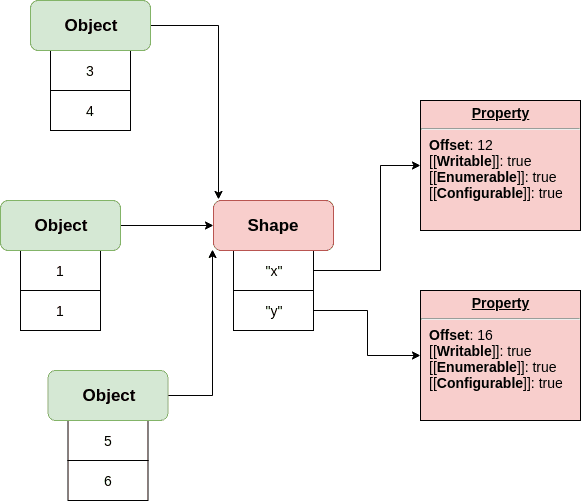
code responsible for this situation might look like
const obj1 = {
x: 1,
y: 1,
};
const obj2 = {
x: 3,
y: 4,
};
const obj3 = {
x: 5,
y: 6,
};Not all objects with the same “structure” have the same Shape
If you compare these two objects
const obj1 = {
x: 1,
y: 1,
};
const obj2 = {};
obj2.x = 1;
obj2.y = 1;they might look the same, but they have a different shape. Shape of the first one we’ve already discussed. Shape of the second one is here
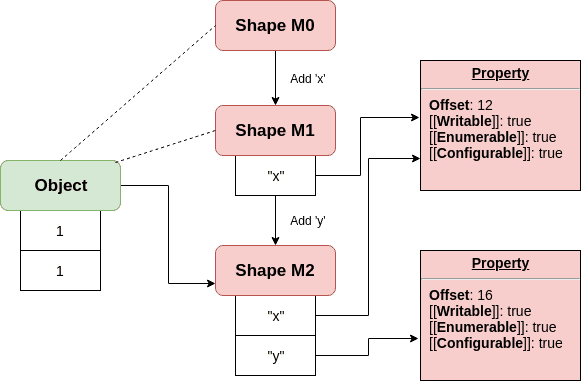
During code execution V8 is creating 3 different shapes and transitions between them to describe end result.
const obj2 = {};
// Shape M0
// add "x": Transition to M1, offset 12
obj2.x = 1;
// Shape M1
// "x": at offset 12
// add "y": Transition to M2, offset 16
obj2.y = 1;
// Shape M2
// "x": at offset 12
// "y": at offset 16the same goes when you’re creating classes
class MyComponent {
constructor(size, name) {
// Shape M0
this.size = size;
// Shape M1
// "size": at some offset
this.name = name;
// Shape M2
// "size": at some offset
// "name": at some other offset
}
}To be 100% honest V8 doesn’t store whole shapes when it does transitions between them.
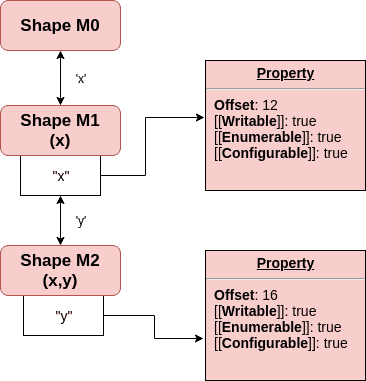
It doesn’t copy information about x property into Shape M2. That allows it to be shaped in a tree like structure when having different objects.
const obj1 = {};
obj1.x = 1;
const obj2 = {};
obj2.x = 1;
obj2.y = 1;
const obj3 = {};
obj3.x = 1;
obj3.z = 1;
obj3.k = 1;
const obj4 = {};
obj4.i = 1;
obj4.j = 'test';
obj4.k = 1;

Notice that even if we using the same attribute name as 3rd property, in obj3 and obj4, these are two different shapes. Reason for that is because shape is related to transition. If you could have a global shape that represents k property, it requires defined offset property. That might work with the same object structures in memory (offset is set base on how much space rest of the object takes before property). So if you have an object like obj4 then property k might have a different offset than property k on obj3 (transition to Shape M7 is different).
Inline Cache (IC)
Maybe start with some code this time?
const N = 1000000;
const obj1 = {};
obj1.name = 'Jake';
function getMeName(o) {
return o.name;
}
for (let i = 0; i < N; i += 1) {
getMeName(obj1);
}and then run this code like
d8 --trace-ic index.jsOff-topic: you might wonder why we’re running function that many times. It’s because V8 won’t try to optimise function unless that function is marked as
hot. And you gethotstatus when running function many times.
Now you can open path/to/v8/tools/ic-explorer.html in your browser. That page allows you to explore what is happening with inline cache.
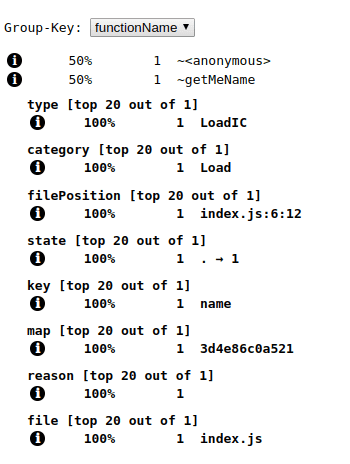
Important part of it is state which can be one of the following states:
- 0 uninitialized
- . premonomorphic
- 1 monomorphic
- ^ recompute handler
- P polymorphic
- N megamorphic
- G generic
In our case state is set to be monomorphic which means that function is optimized to receive only objects with one defined shape.
Now let’s define what IC really is…
Unfortunately, we have to do it in the hard way. By looking into some bytecode (There’s a blog post about understanding bytecode by Franziska Hinkelmann if you’re interested). To do that just run
d8 --print-bytecode index.jsOutput of that is quite long but we’re interested in last part. Look for generated bytecode for function getMeName.
...
[generated bytecode for function: getMeName]
Parameter count 2
Register count 0
Frame size 0
69 E> 0x2d34c959f9d6 @ 0 : a5 StackCheck
86 S> 0x2d34c959f9d7 @ 1 : 28 02 00 00 LdaNamedProperty a0, [0], [0]
91 S> 0x2d34c959f9db @ 5 : a9 Return
Constant pool (size = 1)
0x2d34c959f989: [FixedArray] in OldSpace
- map: 0x0741c8840789 <Map>
- length: 1
0: 0x0741c8843eb9 <String[#4]: name>
Handler Table (size = 0)Look on LdaNamedProperty. This method is responsible for extracting named property from a0(argument 0). Property name (in our case name) is determined by [0] constant from Constant pool.
- map: 0x0741c8840789 <Map>
- length: 1
0: 0x0741c8843eb9 <String[#4]: name>After getting property value from argument, function stores it in the accumulator (function returns accumulator at the end).
That process generates sth we call Inline Cache (IC). Every time function runs with a different object shape it creates a new IC entry.
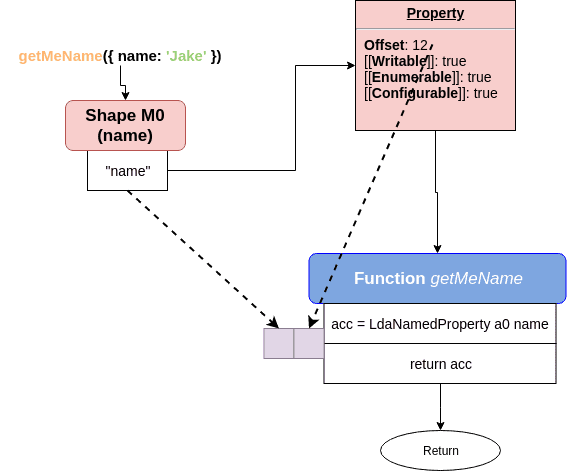
We’ve called getMeName with an object that has given shape M0. First run of the function works as described before so V8 has to look up for named property on a0 and store it into acc. After running bytecode it creates IC which contain two things:
- Shape
- Way to get to property
Now if we call the same function again with an object that has the same shape:
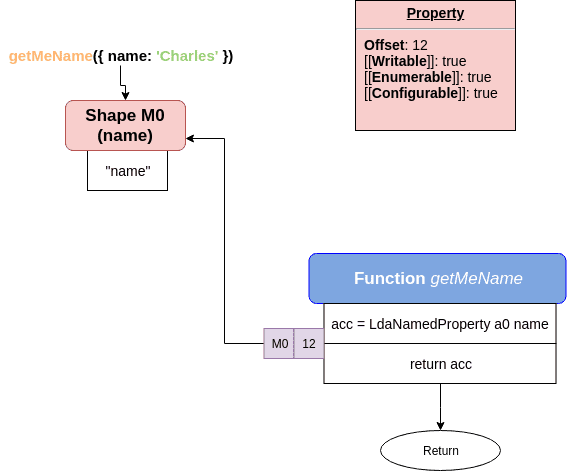
V8 compares current shape with shape stored in IC and skipping whole process of calling LdaNamedProperty, because there is a “shortcut” for this “kind” of shape, stored in IC. That way we have nice optimisation of the function call. But what if we call that function with a different object (different shape)?
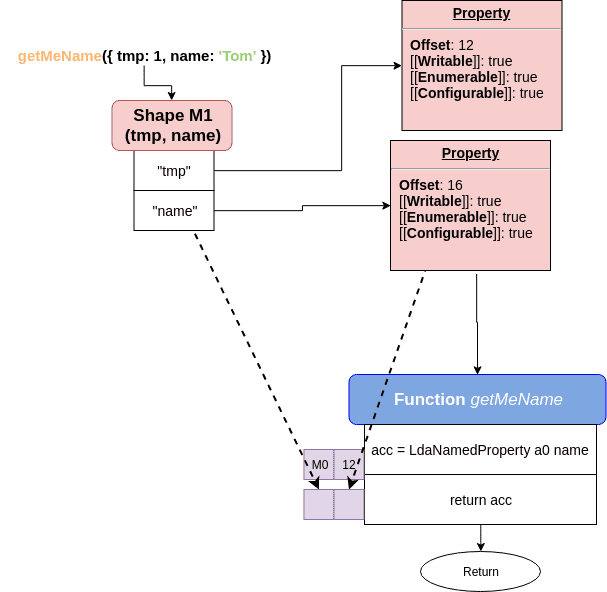
V8 created another IC for shape M1. After that we have “shortcut” for two types of shapes. But how many IC can V8 create for one function? A lot… only problem is, every time it does that there is a deoptimization going one.
Function states
There are different states your function can be in, but we’re mostly interested in 3 of them:
- Monomorphic - 1 IC
- Polymorphic - 2-4 IC
- Megamorphic - >5 IC
While V8 decides if function should be optimized, it check current function state. Only two of them can be optimized: Monomorphic and Polymorphic. Reaching 5 ICs V8 basically means “I have no idea what I’m going, so call it a day”. At this point TurboFan is not going to store anything into IC, instead it fall back to global cache. Usually it doesn’t matter if your function is Megamorphic, but if that function runs very often you might think about optimizing it by reducing a number of different shapes it accepts.
Back to our function
const N = 10000;
let a = { a: 'Jack', b: 'Sparrow' };
let b = { tmp: 3, a: 'Charles', b: 'Xavier' };
let c = { tmp: 3, tmp2: 3, a: 'Frodo', b: 'Baggins' };
let d = { tmp: 3, tmp2: 3, tmp3: 3, a: 'Legolas', b: 'Thranduilion' };
let e = { tmp: 3, tmp2: 3, tmp3: 3, tmp4: 3, a: 'Indiana', b: 'Jones' };
let f = { tmp: 3, tmp2: 3, tmp3: 3, tmp4: 3, tmp5: 3, a: 'Gandalf', b: 'The Grey' };
let f2 = { tmp: 3, tmp2: 3, tmp3: 3, tmp4: 3, tmp5: 3, a: 'Jack', b: 'Sparrow' };
let f3 = { tmp: 3, tmp2: 3, tmp3: 3, tmp4: 3, tmp5: 3, a: 'Charles', b: 'Xavier' };
let f4 = { tmp: 3, tmp2: 3, tmp3: 3, tmp4: 3, tmp5: 3, a: 'Frodo', b: 'Baggins' };
let f5 = { tmp: 3, tmp2: 3, tmp3: 3, tmp4: 3, tmp5: 3, a: 'Legolas', b: 'Thranduilion' };
let f6 = { tmp: 3, tmp2: 3, tmp3: 3, tmp4: 3, tmp5: 3, a: 'Indiana', b: 'Jones' };
function test(obj) {
let result = '';
for (let i = 0; i < N; i += 1) {
result += obj.a + obj.b;
}
return result;
}
function test2(obj) {
let result = '';
for (let i = 0; i < N; i += 1) {
result += obj.a + obj.b;
}
return result;
}
const startT1 = Date.now();
for(let i = 0; i < N; i += 1) {
test(f);
test(f2);
test(f3);
test(f4);
test(f5);
test(f6);
}
console.log("test with one shape:", Date.now() - startT1, "ms.");
const startT2 = Date.now();
for(let i = 0; i < N; i += 1) {
test2(a);
test2(b);
test2(c);
test2(d);
test2(e);
test2(f);
}
console.log("test with multiple shape:", Date.now() - startT2, "ms.");After executing this code it prints:
test with one shape: 3015 ms.
test with multiple shape: 12329 ms.What just happen? First of all we’ve set number of operations to 6*10^8 for every test (6 x 10000 x 10000). First function test is called with the same shape all over again (different objects, same shape). Second function test2 is called with 6 different shapes and because of that V8 is not optimising it.
If you open v8/tools/ic-explorer.html and run above code with d8 --trace-ic index.js. You could be able to load v8.log into ic-explorer. For those who don’t want to do it, here is a screenshot.
test(obj):

test2(obj):
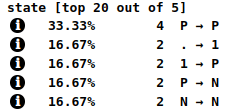
Result of that test is obvious and test() runs 7.8 times faster than test2().
You might ask why creating test2() if it looks the same? It’s because after running test() with one shape it’s already optimised for it. I didn’t want to affect performance of the second run, but still want to keep it in one file.
Extra
I’ve mentioned that shape contains more than just information about added properties. Here is an example of created shape for let b:
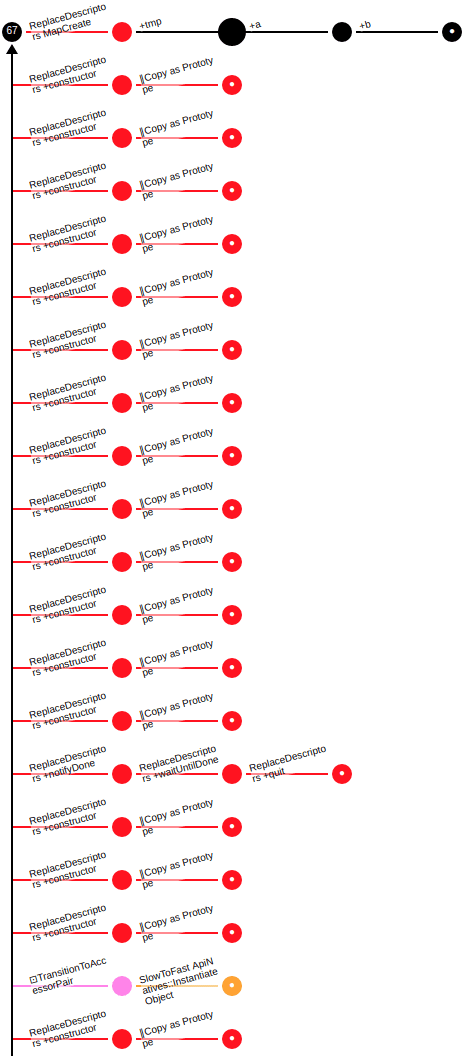
If you want, you can generate that for your code by running
d8 --trace-maps index.jsand uploading v8.log into v8/tools/map-processor.html. When it generates chart, click on Transitions and explore a list of them at the bottom of the page.